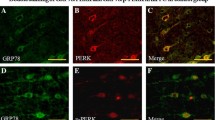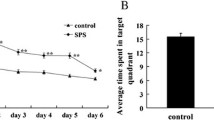Abstract
The purpose of this study is to investigate the change of phosphorylated p44/42 extracellular signal-regulated kinase (pERK1/2) and c-fos expression induced by single-prolonged stress (SPS) in medial prefrontal cortex (mPFC), and to determine whether extracellular signal-regulated kinase (ERK) pathway plays a role in SPS. Before exposure to SPS, Wistar rats were bilaterally infused with PD98059, inhibitor of ERK, into the mPFC. Animals were then tested in the open field (OF), elevated plus-maze (EPM), and Morris water maze (MWM). Brains were removed for immunohistochemical staining and Western blotting of pERK1/2. And reverse transcription-polymerase chain reaction (RT-PCR) was employed to detect the c-fos mRNA, a member of immediate early genes (IGEs) family. SPS exposure resulted in pronounced anxiety-like behavior compared to control animals. SPS-exposed animals also displayed marked learning and spatial memory impairments. PD98059 significantly ameliorated anxiety-like behavior, learning, and spatial memory impairments. Expression of pERK1/2 in mPFC was significantly increased after rats were exposed to SPS, and the increase induced by SPS was significantly abolished by PD98059. The results of RT-PCR showed that the expression of c-fos mRNA had a significant increase in SPS rats compared with control rats, and the increase was significantly abolished by PD98059. The results suggest that pERK1/2 may be related to signal transduction pathway in single-prolonged stress.






Similar content being viewed by others
References
Brandes D, Ben-Schachar G, Gilboa A et al (2002) PTSD symptoms and cognitive performance in recent trauma survivors. Psychiatry Res 110:231–238
Bryant RA, Kemp AH, Felmingham KL et al (2008) Enhanced amygdala and medial prefrontal activation during nonconscious processing of fear in posttraumatic stress disorder: an fMRI study. Hum Brain Mapp 29:517–523
Dawson TM, Ginty DD (2002) CREB family transcription factor inhibit neuronal suicide. Nat Med 8:450–451
Dickie EW, Brunet A, Akerib V et al (2008) An fMRI investigation of memory encoding in PTSD: influence of symptom severity. Neuropsychologia 46:1522–1531
Dziema H, Oatis B, Butcher GQ et al (2003) The ERK/MAP kinase pathway couples light to immediate-early gene expression in the suprachiasmatic nucleus. Eur J Neurosci 17:1617–1627
Figueiredo HF, Bruestle A, Bodie B et al (2003) The medial prefrontal cortex differentially regulates stress-induced c-fos expression in the forebrain depending on type of stressor. Eur J Neurosci 18:2357–2364
Fu AL, Fan F, Li S et al (2008) Role of extracellular signal-regulated kinase signal transduction pathway in anxiety. J Psychiatr Res 43:55–63
Garcia R, Vouimba RM, Baudry M et al (1999) The amygdala modulates prefrontal cortex activity relative to conditioned fear. Nature 402:294–296
Gerrits M, Westenbroek C, Koch T et al (2006) Increased limbic phosphorylated extracellular-regulated kinase 1 and 2 expression after chronic stress is reduced by cyclic 17 beta-estradiol administration. Neuroscience 142:1293–1302
Geuze E, Westenberg HG, Heinecke A et al (2008) Thinner prefrontal cortex in veterans with posttraumatic stress disorder. Neuroimage 41:675–681
Golier JA, Harvey PD, Legge J et al (2006) Memory performance in older trauma survivors: implications for the longitudinal course of PTSD. Ann N Y Acad Sci 1071:54–66
Hetman M, Gozdz A (2004) Role of extracellular signal regulated kinases 1 and 2 in neuronal survival. Eur J Biochem 271:2050–2055
Horger BA, Roth RH (1996) The role of mesoprefrontal dopamine neurons in stress. Crit Rev Neurobiol 10:395–418
Huang EJ, Reichardt LF (2001) Neurotrophins: roles in neuronal development and function. Annu Rev Neurosci 24:677–736
Imanaka A, Morinobu S, Toki S et al (2006) Importance of early environment in the development of post-traumatic stress disorder-like behaviors. Behav Brain Res 173:129–137
Iwamoto Y, Morinobu S, Takahashi T et al (2007) Single prolonged stress increases contextual freezing and the expression of glycine transporter 1 and vesicle-associated membrane protein 2 mRNA in the hippocampus of rats. Prog Neuropsychopharmacol Biol Psychiatry 31:642–651
Khan S, Liberzon I (2004) Topiramate attenuates exaggerated acoustic startle in an animal model of PTSD. Psychopharmacology (Berl) 172:225–229
Kruse MS, Premont J, Krebs MO et al (2009) Interaction of dopamine D1 with NMDA NR1 receptors in rat prefrontal cortex. Eur Neuropsychopharmacol 19:296–304
Lauzon NM, Bishop SF, Laviolette SR (2009) Dopamine D1 versus D4 receptors differentially modulate the encoding of salient versus nonsalient emotional information in the medial prefrontal cortex. J Neurosci 29:4836–4845
Liberzon I, Krstov M, Young EA (1997) Stress–restress: effects on ACTH and fast feedback. Psychoneuroendocrinology 22:443–453
Morilak DA, Barrera G, Echevarria DJ et al (2005) Role of brain norepinephrine in the behavioral response to stress. Prog Neuropsychopharmacol Biol Psychiatry 29:1214–1224
Paxinos G, Watson C (1998) The rat brain in stereotaxic coordinates. Academic Press, San Diego
Putnam KM, Pizzagalli DA, Gooding DC et al (2008) Neural activity and diurnal variation of cortisol: evidence from brain electrical tomography analysis and relevance to anhedonia. Psychophysiology 45:886–895
Radley JJ, Arias CM, Sawchenko PE (2006) Regional differentiation of the medial prefrontal cortex in regulating adaptive responses to acute emotional stress. J Neurosci 26:12967–12976
Ressler KJ, Nemeroff CB (2000) Role of serotonergic and noradrenergic systems in the pathophysiology of depression and anxiety disorders. Depress and Anxiety 12:2–19
Rothbaum BO, Kozak MJ, Foa EB et al (2001) Posttraumatic stress disorder in rape victims: autonomic habituation to auditory stimuli. J Trauma Stress 14:283–293
Rubinfeld H, Seger R (2005) The ERK cascade: a prototype of MAPK signaling. Mol Biotechnol 31:151–174
Ryu J, Futai K, Feiliu M et al (2008) Constitutively active Rap2 transgenic mice display fewer dendritic spines, reduced extracellular signal-regulated kinase signaling, enhanced long-term depression, and impaired spatial. J Neurosci 28:8178–8188
Scornaiencki R, Cantrup R, Rushlow WJ et al (2009) Prefrontal cortical D1 dopamine receptors modulate subcortical D2 dopamine receptor-mediated stress responsiveness. Int J Neuropsychopharmacol 11:1–14
Shin LM, Wright CI, Cannistraro PA et al (2005) A functional magnetic resonance imaging study of amygdala and medial prefrontal cortex responses to overtly presented fearful faces in posttraumatic stress disorder. Arch Gen Psychiatry 62:273–281
Takahashi T, Morinobu S, Iwamoto Y et al (2006) Effect of paroxetine on enhanced contextual fear induced by single prolonged stress in rats. Psychopharmacology (Berl) 189:165–173
Wang W, Liu Y, Zheng H et al (2008) A modified single-prolonged stress model for post-traumatic stress disorder. Neurosci Lett 441:237–241
Weeber EJ, Sweatt JD (2002) Molecular neurobiology of human cognition. Neuron 33:845–848
Weiss SJ (2007) Neurobiological alterations associated with traumatic stress. Perspect Psychiatr Care 43:112–114
Willliams LM, Kemp AH, Felmingham KL et al (2006) Trauma modulates amygdala and medial prefrontal responses to consciously attended fear. Neuroimage 29:347–357
Yehuda R (2005) Neuroendocrine aspects of PTSD. Handb Exp Pharmacol 371-403
Yu J, Liu C, Zhang X, Han J (2005) Acupuncture improved cognitive impairment caused by multi-infarct dementia in rats. Physiol Behav 86:434–441
Zheng G, Chen YM, Zhang XP et al (2008) Acute cold exposure and rewarming enhanced spatial memory and activated the MAPK cascades in the rat brain. Brain Res 1239:171–180
Acknowledgments
This research was supported by a grant from the National Natural Science Foundation of China (No. 30600341) and the Natural Science Foundation of Hebei Province (No. C2009001247). The authors are thankful for all the help from the China Medical University Experiment Center for their technical support. The authors also wish to express their appreciation to Dr. Ying Sun, North China Coal Medical University for the assistance.
Author information
Authors and Affiliations
Corresponding author
Rights and permissions
About this article
Cite this article
Wang, HT., Han, F., Gao, JL. et al. Increased Phosphorylation of Extracellular Signal-Regulated Kinase in the Medial Prefrontal Cortex of the Single-Prolonged Stress Rats. Cell Mol Neurobiol 30, 437–444 (2010). https://doi.org/10.1007/s10571-009-9468-1
Received:
Accepted:
Published:
Issue Date:
DOI: https://doi.org/10.1007/s10571-009-9468-1




